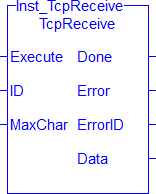 TcpReceive
TcpReceive
Description
This function block receives characters over a socket connection. It is possible that the number of characters actually received is less than the number expected. In that case, you will have to call the function again on the next cycle to receive the pending characters.
-
- It is possible that the socket becomes invalid if an error occurs in the TCP connection after this function block is called. You must use the TcpIsValid function block after TcpSend. If the socket is no longer valid then you must close it by using the TcpClose function block.

Figure 7-225: The TcpReceive function block
Related Functions
TcpAccept, TcpBinReceive, TcpBinSend, TcpClose, TcpConnect, TcpIsConnected, TcpIsValid, TcpListen, TcpSend
Arguments
Input
| Execute | Description | On the rising edge |
| Data Type | BOOL | |
| Range | 0, 1 | |
| Unit | N/A | |
| Default | — | |
| ID | Description | The ID of the client socket |
| Data Type | UDINT | |
| Range | N/A | |
| Unit | N/A | |
| Default | — | |
| MaxChar | Description | The number of characters to receive. |
| Data Type | STRING | |
| Range | N/A | |
| Unit | user units | |
| Default | — |
Output
| Done | Description | If TRUE, then the command completed successfully |
| Data Type | BOOL | |
| Error | Description | If TRUE, an error has occurred |
| Data Type | BOOL | |
| ErrorID | Description | Indicates the error if Error output is set to TRUE. See the table in Search IndexFile and TCP/IP Function Block ErrorID Output |
| Data Type | DINT | |
| Data | Description | String of received characters |
| Data Type | STRING |
Example
Structured Text
(* TcpReceive example *)
CASE StepCounter OF
0:
Inst_TcpReceive(TRUE, MySocketID, 128);
StepCounter := StepCounter + 1;
1:
Inst_TcpReceive(TRUE, MySocketID, 128);
IF Inst_TcpReceive.Done THEN
ReceivedData := Inst_TcpReceive.Data;
Inst_TcpReceive(FALSE, 0, 0);
StepCounter := StepCounter + 1;
END_IF;
END_CASE;






